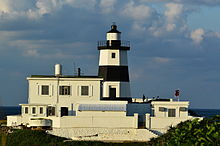Fuguijiao Lighthouse
 | |
 | |
| Location | Laomei Village Shimen District New Taipei City Taiwan |
|---|---|
| Coordinates | 25°17′55″N 121°32′12″E / 25.298536°N 121.536665°E |
| Tower | |
| Constructed | 1949 |
| Construction | reinforced concrete tower |
| Height | 14.3 m (47 ft)[1] |
| Shape | octagonal tower with balcony and lantern on a one-story keeper’s house[2] |
| Markings | white and black-band tower,[2] white lantern, black lantern dome |
| Operator | Maritime and Port Bureau[1] |
| Fog signal | one 3s. blast every 30s.[2][1] |
| Light | |
| First lit | 1962 |
| Focal height | 31.4 m (103 ft)[1] |
| Range | 26.8 nmi (49.6 km; 30.8 mi)[1] |
| Characteristic | Fl (2) W 15s.[2][1] |
| Fuguijiao Lighthouse | |||||||||||||
|---|---|---|---|---|---|---|---|---|---|---|---|---|---|
| Chinese name | |||||||||||||
| Traditional Chinese | 富貴角燈塔 | ||||||||||||
| Simplified Chinese | 富贵角灯塔 | ||||||||||||
| Postal | Fukwei Chiao Lighthouse | ||||||||||||
| |||||||||||||
| Japanese name | |||||||||||||
| Kanji | 富貴角灯台 | ||||||||||||
| Hiragana | ふうきかくとうだい | ||||||||||||
| |||||||||||||
The Fuguijiao or Cape Fugui Lighthouse is a lighthouse on Cape Fugui near Laomei Village (老梅里, Lǎoméi Lǐ) in Shimen District, New Taipei City, Taiwan.
Name
The lighthouse is named after nearby Cape Fugui, the northernmost point of Taiwan. Its Japanese name was Fūki Kaku. Its Chinese name (derived from a Hokkien transcription of the Dutch word hoek, meaning "hook" or "cape")[3] is also romanized Cape Fukwei[2] for the Chinese Postal Map, Fu-kuei Chiao using simplified Wade-Giles,[2] and Fugueijiao from Tongyong Pinyin. It was also sometimes known in English as the Hoek Lighthouse.[4]
History
A structure was first erected on the rocks at Cape Fugui in 1896[5][6] or 1897[1][7] by the occupying Japanese. It was a terminus for undersea cables[8] from the Japanese islands and its construction materials all came from there.[7] It was ruined during World War II but its remains were used by China's Nationalist government for the erection of a 30 m (98 ft)[6] octagonal iron lighthouse[1] in 1949.[5] The foghorn was particularly needful, owing to poor visibility in the area during the fall and winter months.[1]
The lighthouse's current 14.3 m (47 ft) concrete black-and-white octagonal tower was raised in 1962.[1][8] The height was greatly reduced to improve the reception of the nearby air force radar station.[6]
Taiwan's Customs traditionally welcomed visitors to the lighthouse once a year on Tax Day as an open house gesture.[4] After the enthusiastic public response to opening Eluanbi Lighthouse to more general tourism, Taiwan's Maritime and Port Bureau decided to open Fuguijiao to regular visitors in 2015.[9] The first tourists were allowed onto the grounds on September 5, making it the 11th Taiwanese lighthouse opened to the general public.[6] It remains inaccessible on weekdays because of the radar station.[5] The tower itself remains closed to the public.[2]
Transportation
The lighthouse is located about 2 km (1.2 mi) north of Laomei Village,[2] off Provincial Highway 2.
See also
References
Citations
- ^ a b c d e f g h i j MPB (2016), "Fukwei Chiao Lighthouse".
- ^ a b c d e f g h Rowlett, Russ. "Lighthouses of Taiwan: Northern". The Lighthouse Directory. University of North Carolina at Chapel Hill.
- ^ Caltonhill, Mark (4 May 2012), "富貴角 Fuguei Cape, New Taipei City", From Takow to Kaohsiung, Blogspot.
- ^ a b "12 Lighthouses in Taiwan to Open to Public on June 30", Want China Times, 7 June 2012, archived from the original on 27 February 2012, retrieved 19 February 2015.
- ^ a b c NTC (2019), "Fugui Cape".
- ^ a b c d MPB (2016), "Maritime and Port Bureau Facilitates the Fugueijiao Lighthouse".
- ^ a b NTC (2019), "Fugui Cape Lighthouse".
- ^ a b "Taiwan's Century-Old Fugueijiao Lighthouse Opened to Public", Want China Times, 31 August 2015, archived from the original on 27 February 2012, retrieved 19 February 2015.
- ^ Wang Shu-fen; et al. (21 February 2015), "Taiwan to Open Two More Lighthouses to Visitors", Focus Taiwan.
Bibliography
- Official site, Taipei: Maritime and Port Bureau of the Ministry of Transportation and Communication, 2016.
- Official site, New Taipei City: Tourism and Travel Department, 2019.

